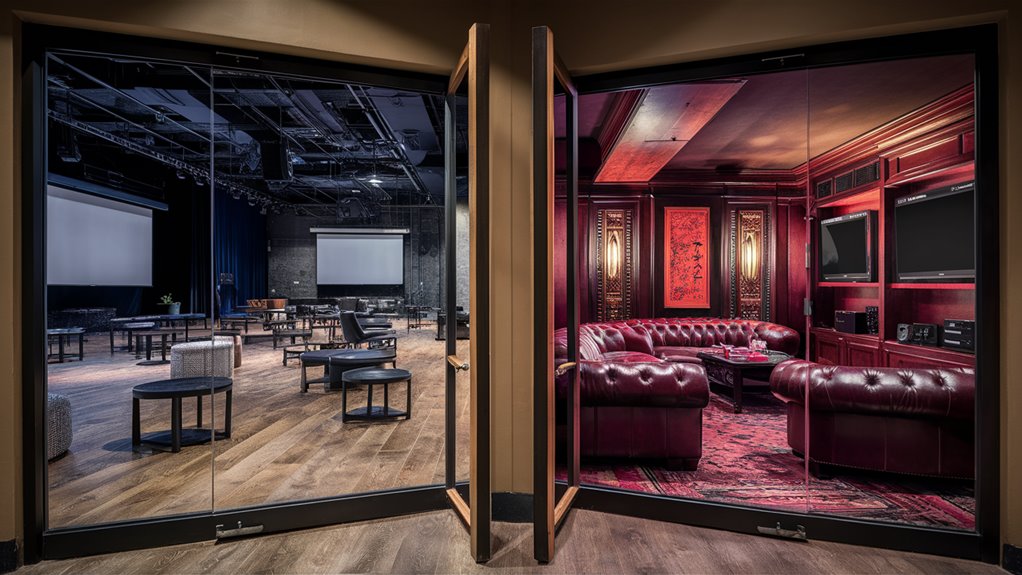
Karaoke Lounge VS KTV Room: The Key Differences
Karaoke Entertainment at its Core
Differentiated karaoke lounges and KTV rooms. A karaoke lounge, a traditional karaoke environment, operates as a public venue; in this single bar-like setting singers face other patrons. However, unlike the first type of KTV in society–Daisy’s Bar with its chamois-padded doors and mosquitoes flying around–such a place remains researchable to any group or individual who are so inclined.
Price and Payment Methods
The difference in Pricing
Between the two venues indeed
Classical Karaoke lounges in general, where customers are charged according to the number of songs they sing
KTV rooms on the other hand rely on an hourly fee that ranges from $30 to 100.
The more high-end KTV places have a free drinks bill.
Equipment and Equipment
KTV Room Facilities
Top-notch touch screen interfaces
Better sound systems
There is room service for every room
Fine quality music selection
KTV Bar
But there you can sing and make merry together with your friends in comfort at the same time.
Karaoke Performance Environment
The performance environment
The greatest difference was in the performance environment. Karaoke lounges create a concert-style setting where confident singers can belt it out, but in KTV rooms there is no such public venue and everyone might feel uncomfortable performing in public.
The Origins and Evolution
Origins and Evolution of Karaoke Entertainment
The Birth of the New Karaoke Culture
Just as karaoke entertainment was born–Carden Shou’s birth was also through the twin tracks of innovation that have resulted in today’s type of karaoke room.
In the ’70s Daisuke Inoue, a Japanese actor/musical inventor, invented the first karaoke machine. The term “karaoke,” which might be translated simply as “empty orchestra,” symbolizes a global entertainment trend that has spread out everywhere from Asia to Europe, Asia and now America all over the world!
Unrelated Evolution: Karaoke Lounges and KTV Rooms
Before we delve into this subject it is probably best to briefly mention the inimitable KTV Place where one would watch their very own television screen as well as those in seats around them.
At the same time, the 1980s saw the independent development of KTV (Karaoke Television) rooms in South Korea and Taiwan, bringing a different kind of singing entertainment concept with them. These parallel developments produced two types of dominant formats that still influence the industry today.
Westernized Karaoke Culture and the East-Asian Experience
In the West, karaoke culture is embodied by public performance spaces where singers entertain packed bars. The two categories of karaoke culture reflect different cultural traditions and social preferences: Traditional karaoke Lounges
Here are public Karaoke lounges
Filled with crowded guests
Mixing with strangers over drinks
Recreational atmosphere similar to bars or clubs
KTV
A vain cultural experience
Here the karaoke here is not accessible to the general public and most people will sing in large groups
Elegant decorations, good service and comfortable environment
All amenities premium quality
The development of both public and private singing entertainment continues and broadens into different sounds around the world today.
Public Vs Private Experience
Public and Private karaoke Experiences: Understanding the Key Differences
On the Evolution of Modern Karaoke Venues
The karaoke lounge and KTV room are the two main formats of singing entertainment, and their key difference lies in what kind of social experience and performance environment they offer.
Kashmiriyat Traditional Karaoke Lounge: Public Stage Experience
Karaoke lounges provide a bustling public setting that resembles the environment of a traditional tavern. Trick-or-treats are held there.
The design of these establishments is meant to create an exciting, high energy environment.
The public performance environment provides: Gaining instant momentum New charisma from larger areas of live entertainment Mixed gatherings of people with different musical tastes Recreating upon the spot to suit whatever materials are at hand
KTV Rooms: Dens of Private Entertainment
KTV (Karaoke Television) rooms deliver a completely different experience through private entertainment facilities for small-scale gatherings. These venues offer:
Local dynasty singing enclosures and pledged audio technology and original programs Comfortable, easygoing lounge-style seats A real leisurely space The private room format allows singers to: Repetitively try How to Sound Better at Karaoke Even Without Singing Lessons difficult songs Experiment with vocal techniques Harangue audiences as they happen through microphones Like a taste-making anchor
They set the environment.
One advantage is that both KTV rooms and KTV lounges are set in a controlled environment which seems designed expressly for friendly social intercourse among familiars singing and having a good time; another is improvements with an audience.
Comparison of Pricing Models for Karaoke and KTV
Pricing for traditional Karaoke Lounges
KTV Lounge Pricing KTV lounges have a straightforward “per song” fee structure or simply an entrance charge.
Primary costs include: Cost of each individual song Purchase of drinks at the bar Minimum requirements for drinks Cover charge at entry After constructing KTV room rates, setting spatial reservation times appropriately for a period of time lasting approximately two months; these rates are also decided after considering frequency and the average person’s income level on all sides (e.g., “It’s Monday, I want to hold my party on Tuesday and take it low”). Room size price KTV’s hourly rates are based on a comprehensive bookable hourly room system that seems to charge according to multi-faceted factors such as: Details of KTV’s hourly rates Price equals form Saturday price equals form no waiting period between songs
Points of Extra Charge for KTV Services
Extending into this realm of consumption are “extravagant” KTV both food and beverage package charges. Bottle service and special amenities charges also apply; timing is equally important.
Value Analysis and Economic Efficiency
Group economics in KTV settings tend to yield better value:
Hourly rates split among participants
Guaranteed time for continuous singing
“This is thanks to KTV. I had a class reunion with another student from our school today, and we will definitely be back at KTV for singing tomorrow morning.” Private entertainment area
For example karaoke places might typically serve only Western-style favorites, such as rock ‘n’ roll or pop tunes from abroad. Even if they did bring in some Chinese songs, who would want to listen to them? Besides the basic Western hit, Chinese youngsters have begun to turn away from “music for the Party,” including rock and classical. They like songs launched every Spring Festival better because these suit their own taste (such as downloading from popular sites over time). So quite an advance on sales already through better technology (such as CD ROMS with more Chinese young people able to join in activities).

How Music Selection Works and Technology in Karaoke Venues
How Music Selection Works in KTV Lounges KTV rooms tend to have advanced entertainment facilities.
They must be equipped for this century.
A fully equipped KTV establishment offers a super clean, classically beautiful environment and unabashedly modern technology.
Improved Libraries of Music
Asian Happy Pop (e.g., K-pop, J-pop, etc.), and newly released hits too
Western tunes
Updates on the Latest in Music
Crossover and Integration of Newest Releases
That’s the new standard.
Modern KTVs are equipped with advanced audio options such as:
Voice modulation keys
Adjustment controls for reverberation effect
Separation enhancement devices
Mobile Integration — Like A Song App
Remote Cooperation: Bulk information
Smartphone compatibility
These A-list improvements establish KTV venues as favorites of tech-savvy performers who seek the ultimate in singing experiences.
Culture and Social Dynamics
Cultural Dynamics in Contemporary Karaoke Joints more see
Karaoke Social Atmosphere in Asia vs. The West
When it comes to Different cultural traditions produce fundamentally different karaoke bar experiences.
Western-style karaoke lounges create livelier, more rousingly feeling environments for singing people alone in front of an audience.
Such places as these would create a concert atmosphere, with the crowd enjoying some enthusiastic brushwood to burn in their favor and being temperamentally prone to rive anaw upon a whim when they are moved like this.
Private KTV Box Experiences
By contrast, Chinese Happy People Music establishments feature luxurious private boxes to please friends of such as one’s ancestors.
There the Boss knows you personally. Pitching his boorishly peacock fan-paint at you and straining itself to say “Congratulations…”
Cultural Patterns of Behavior
Social Norms At Western Karaoke Venues
Single and combined performer
Breaking into song from the crowd
Joining In & Making Flat For So-and
Others enjoying the light only of public as well also hiding themselves are shadowed out from within while still missing virtually any gains which are ended up world-wide for just such kinds ops that.
Asian KTV Social Customs
Centered on the group
The meal is shared by all
They take turns
Together everyone enjoys, and feelings of fulfillment are spread around. The most fundamental contrast here lies in their basic eye: while Western karaoke lounges emphasize solitary performance and public entertainment, Asian KTV boxes provide altogether different service — they emphasize the collective sharing of joy. These different methods of thought each harbor within them varying cultural attitudes toward group relations and social interaction in show settings.



